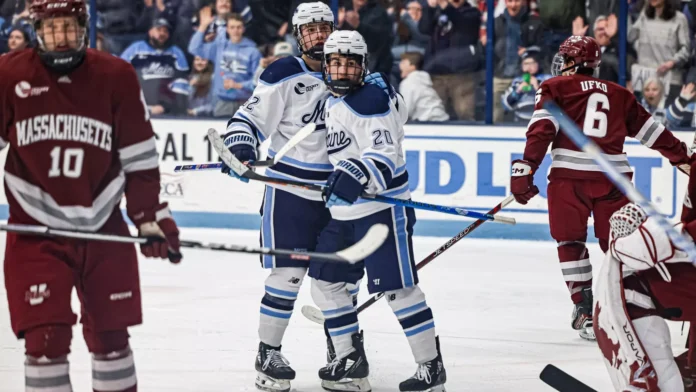
Eligibility changes have started a new chapter of university hockey in North America. The change will give young players more options and change recruiting for teams on both sides of the border
On Nov. 8, the National Collegiate Athletics Association (NCAA) Division I Council, in the United States, approved a new rule that allows players from the Canadian Hockey League (CHL) to play in the NCAA.
Previously, if a player stepped on the ice for a CHL team they lost their ability to play in the NCAA. This was because some CHL players sign entry-level contracts with NHL teams, which designates them as professionals.
The landmark decision comes into effect on August 1.
The first player to take advantage of the new rule was Jackson Parsons, a goalie for the Kitchener Rangers of the Ontario Hockey League within the CHL. Parsons committed to play for Clarkson University next season.
Although the rule change has garnered positive reactions, it could negatively impact recruitment efforts for university hockey in Canada.
University Sports (U Sports) teams in Canada may risk losing top CHL talent who can now commit to NCAA teams south of the border.
Before this rule, players had no option to continue their careers in the U.S. Instead, they could continue playing for one of the 35 university teams in Canada.
The rule change could give way to younger players entering U Sports if older CHL players opt for NCAA schools.
Forbes MacPherson is the head coach of the University of Prince Edward Island (UPEI) men’s hockey team. For him, the change was not a complete surprise. He said “there was some indication” late this summer.
“We knew that this would happen when it broke out and things seemed to happen fast. So, it wasn’t a complete surprise,” said MacPherson.
He added that before this change many players on Canadian junior teams would “exhaust” their career eligibility before moving on to U Sports.
When recruiting for UPEI each year, MacPherson first looks at 20-year-old players in the CHL. He said there are about 225 athletes divided between the 75 Canadian junior teams.
Then, the team looks for players in second-tier leagues, particularly those playing for the Summerside Western Capitals in the Maritime Hockey League.
Now, MacPherson will have to “adjust on the fly” regarding his recruiting approach. With the change being so fresh he’s unsure what the adjustment will look like.
He does know that his recruitment pool will continue to shrink as he sees more and more 20-year-old major junior players committing to NCAA programs.
“As those commitments happen, those players will come off our recruiting list. So, I feel what will happen is we will just end up doing a deeper dive into tier-two hockey,” said MacPherson. “We’re treading new water here and we’ll see how the landscape changes, if at all, but we feel like it will.”
Like U Sports, the rule change is set to affect NCAA hockey.
In the U.S., 64 college hockey teams recruit their players from lower-level junior hockey leagues, such as the USHL. The change will give teams the choice to add CHL players to their rosters, creating situations where they are battling with U Sports for top-level talent.
“My reaction is it’s just something that was inevitably going to happen,” said Ben Barr, the head coach of the University of Maine men’s hockey team.
The team plays in the Hockey East NCAA Division I conference.
Barr said that since the University of Maine is near Quebec and Ontario the change will “be a beneficial thing.”
“It’s a new world for us. I’m more excited about it than I thought I would be, just because there are so many possibilities now,” he said.
Barr said that the CHL and NCAA as leagues are set up similarly. In both leagues, some teams tend to dominate every season, while others are “lower in the pecking order.”
Barr is no stranger to recruiting Canadian junior talent. He recently brought Josh and Bradly Nadeau to Maine from St-François-de-Madawaska, New Brunswick, near Edmundston on the U.S. Canada border.
The Nadeau brothers played in the BCHL before making the jump to the NCAA.
The duo played together last season at the University of Maine. They led the team with a combined 91 points in 37 games.
This season Josh is a key piece of the squad. Bradly has moved on to the Chicago Wolves of the AHL after being drafted 30th overall in 2023 by the NHL’s Carolina Hurricanes.
“The hope for us is [to] create good relationships with some of these CHL teams that we’ve never had any relationships with because the worlds don’t cross,” said Barr.
Barr recently made a trip to Saint John to watch the city’s CHL team take on the Charlottetown Islanders. He said he took the chance to talk with both team’s coaches.
“I just hope that we can create a logical development path in partnership with the CHL.”
